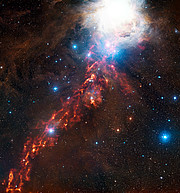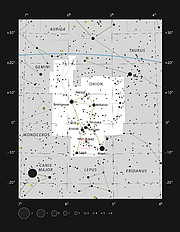Press Release
Orion's Hidden Fiery Ribbon
15 May 2013
This dramatic new image of cosmic clouds in the constellation of Orion reveals what seems to be a fiery ribbon in the sky. This orange glow represents faint light coming from grains of cold interstellar dust, at wavelengths too long for human eyes to see. It was observed by the ESO-operated Atacama Pathfinder Experiment (APEX) in Chile.
Clouds of gas and interstellar dust are the raw materials from which stars are made. But these tiny dust grains block our view of what lies within and behind the clouds — at least at visible wavelengths — making it difficult to observe the processes of star formation.
This is why astronomers need to use instruments that are able to see at other wavelengths of light. At submillimetre wavelengths, rather than blocking light, the dust grains shine due to their temperatures of a few tens of degrees above absolute zero [1]. The APEX telescope with its submillimetre-wavelength camera LABOCA, located at an altitude of 5000 metres above sea level on the Chajnantor Plateau in the Chilean Andes, is the ideal tool for this kind of observation.
This spectacular new picture shows just a part of a bigger complex called the Orion Molecular Cloud, in the constellation of Orion (The Hunter). A rich melting pot of bright nebulae, hot young stars and cold dust clouds, this region is hundreds of light-years across and located about 1350 light-years from us. The submillimetre-wavelength glow arising from the cold dust clouds is seen in orange in this image and is overlaid on a view of the region taken in the more familiar visible light.
The large bright cloud in the upper right of the image is the well-known Orion Nebula, also called Messier 42. It is readily visible to the naked eye as the slightly fuzzy middle “star” in the sword of Orion. The Orion Nebula is the brightest part of a huge stellar nursery where new stars are being born, and is the closest site of massive star formation to Earth.
The dust clouds form beautiful filaments, sheets, and bubbles as a result of processes including gravitational collapse and the effects of stellar winds. These winds are streams of gas ejected from the atmospheres of stars, which are powerful enough to shape the surrounding clouds into the convoluted forms seen here.
Astronomers have used these and other data from APEX along with images from ESA’s Herschel Space Observatory, to search the region of Orion for protostars — an early stage of star formation. They have so far been able to identify 15 objects that appeared much brighter at longer wavelengths than at shorter wavelengths. These newly discovered rare objects are probably among the youngest protostars ever found, bringing astronomers closer to witnessing the moment when a star begins to form.
Notes
[1] Hotter objects give off most of their radiation at shorter wavelengths and cooler ones at longer wavelengths. As an example very hot stars (surface temperatures around 20 000 degrees Kelvin) look blue and cooler ones (surface temperatures of around 3000 degrees Kelvin) look red. And a cloud of dust with a temperature of only ten degrees Kelvin has its peak of emission at a much longer wavelength — around 0.3 millimetres — in the part of the spectrum where APEX is very sensitive.
More information
The research on protostars in this region is described in the paper “A Herschel and APEX Census of the Reddest Sources in Orion: Searching for the Youngest Protostars” by A. Stutz et al., in the Astrophysical Journal.
The APEX observations used in this image were led by Thomas Stanke (ESO), Tom Megeath (University of Toledo, USA), and Amelia Stutz (Max Planck Institute for Astronomy, Heidelberg, Germany). APEX is a collaboration between the Max Planck Institute for Radio Astronomy (MPIfR), the Onsala Space Observatory (OSO) and ESO. Operation of APEX at Chajnantor is entrusted to ESO.
ESO is the foremost intergovernmental astronomy organisation in Europe and the world’s most productive ground-based astronomical observatory by far. It is supported by 15 countries: Austria, Belgium, Brazil, Czechia, Denmark, France, Finland, Germany, Italy, the Netherlands, Portugal, Spain, Sweden, Switzerland and the United Kingdom. ESO carries out an ambitious programme focused on the design, construction and operation of powerful ground-based observing facilities enabling astronomers to make important scientific discoveries. ESO also plays a leading role in promoting and organising cooperation in astronomical research. ESO operates three unique world-class observing sites in Chile: La Silla, Paranal and Chajnantor. At Paranal, ESO operates the Very Large Telescope, the world’s most advanced visible-light astronomical observatory and two survey telescopes. VISTA works in the infrared and is the world’s largest survey telescope and the VLT Survey Telescope is the largest telescope designed to exclusively survey the skies in visible light. ESO is the European partner of a revolutionary astronomical telescope ALMA, the largest astronomical project in existence. ESO is currently planning the 39-metre European Extremely Large optical/near-infrared Telescope, the E-ELT, which will become “the world’s biggest eye on the sky”.
Links
- Related press releases:
- Research paper
- Photos of APEX
- Photos taken by APEX
Contacts
Amelia Stutz
Max Planck Institute for Astronomy
Heidelberg, Germany
Tel: +49 6221 528 412
Email: stutz@mpia.de
Thomas Stanke
ESO
Garching bei München, Germany
Tel: +49 89 3200 6116
Email: tstanke@eso.org
Richard Hook
ESO Public Information Officer
Garching bei München, Germany
Tel: +49 89 3200 6655
Cell: +49 151 1537 3591
Email: rhook@eso.org
About the Release
| Release No.: | eso1321 |
| Name: | Orion Molecular Cloud |
| Type: | Milky Way : Nebula : Appearance : Dark |
| Facility: | Atacama Pathfinder Experiment |
| Instruments: | LABOCA |
| Science data: | 2013ApJ...767...36S |
Our use of Cookies
We use cookies that are essential for accessing our websites and using our services. We also use cookies to analyse, measure and improve our websites’ performance, to enable content sharing via social media and to display media content hosted on third-party platforms.
ESO Cookies Policy
The European Organisation for Astronomical Research in the Southern Hemisphere (ESO) is the pre-eminent intergovernmental science and technology organisation in astronomy. It carries out an ambitious programme focused on the design, construction and operation of powerful ground-based observing facilities for astronomy.
This Cookies Policy is intended to provide clarity by outlining the cookies used on the ESO public websites, their functions, the options you have for controlling them, and the ways you can contact us for additional details.
What are cookies?
Cookies are small pieces of data stored on your device by websites you visit. They serve various purposes, such as remembering login credentials and preferences and enhance your browsing experience.
Categories of cookies we use
Essential cookies (always active): These cookies are strictly necessary for the proper functioning of our website. Without these cookies, the website cannot operate correctly, and certain services, such as logging in or accessing secure areas, may not be available; because they are essential for the website’s operation, they cannot be disabled.
Functional Cookies: These cookies enhance your browsing experience by enabling additional features and personalization, such as remembering your preferences and settings. While not strictly necessary for the website to function, they improve usability and convenience; these cookies are only placed if you provide your consent.
Analytics cookies: These cookies collect information about how visitors interact with our website, such as which pages are visited most often and how users navigate the site. This data helps us improve website performance, optimize content, and enhance the user experience; these cookies are only placed if you provide your consent. We use the following analytics cookies.
Matomo Cookies:
This website uses Matomo (formerly Piwik), an open source software which enables the statistical analysis of website visits. Matomo uses cookies (text files) which are saved on your computer and which allow us to analyze how you use our website. The website user information generated by the cookies will only be saved on the servers of our IT Department. We use this information to analyze www.eso.org visits and to prepare reports on website activities. These data will not be disclosed to third parties.
On behalf of ESO, Matomo will use this information for the purpose of evaluating your use of the website, compiling reports on website activity and providing other services relating to website activity and internet usage.
Matomo cookies settings:
Additional Third-party cookies on ESO websites: some of our pages display content from external providers, e.g. YouTube.
Such third-party services are outside of ESO control and may, at any time, change their terms of service, use of cookies, etc.
YouTube: Some videos on the ESO website are embedded from ESO’s official YouTube channel. We have enabled YouTube’s privacy-enhanced mode, meaning that no cookies are set unless the user actively clicks on the video to play it. Additionally, in this mode, YouTube does not store any personally identifiable cookie data for embedded video playbacks. For more details, please refer to YouTube’s embedding videos information page.
Cookies can also be classified based on the following elements.
Regarding the domain, there are:
- First-party cookies, set by the website you are currently visiting. They are stored by the same domain that you are browsing and are used to enhance your experience on that site;
- Third-party cookies, set by a domain other than the one you are currently visiting.
As for their duration, cookies can be:
- Browser-session cookies, which are deleted when the user closes the browser;
- Stored cookies, which stay on the user's device for a predetermined period of time.
How to manage cookies
Cookie settings: You can modify your cookie choices for the ESO webpages at any time by clicking on the link Cookie settings at the bottom of any page.
In your browser: If you wish to delete cookies or instruct your browser to delete or block cookies by default, please visit the help pages of your browser:
Please be aware that if you delete or decline cookies, certain functionalities of our website may be not be available and your browsing experience may be affected.
You can set most browsers to prevent any cookies being placed on your device, but you may then have to manually adjust some preferences every time you visit a site/page. And some services and functionalities may not work properly at all (e.g. profile logging-in, shop check out).
Updates to the ESO Cookies Policy
The ESO Cookies Policy may be subject to future updates, which will be made available on this page.
Additional information
For any queries related to cookies, please contact: pdprATesoDOTorg.
As ESO public webpages are managed by our Department of Communication, your questions will be dealt with the support of the said Department.






